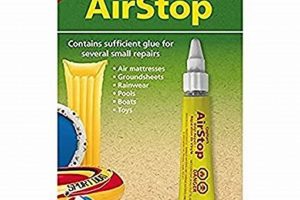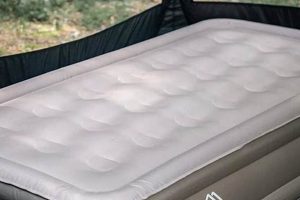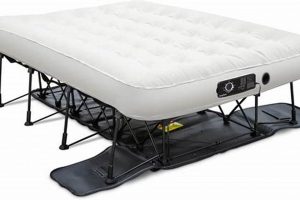An inflatable sleeping surface designed for use with a camping cot or similar elevated frame provides increased comfort and support compared to sleeping directly on the cot’s fabric. This type of bedding often features internal baffling to distribute weight evenly and prevent sagging, enhancing the user’s sleep quality.
Employing this type of inflatable bedding elevates the user off the ground, offering protection from uneven terrain, moisture, and insects. Furthermore, its use can significantly improve insulation in colder environments. Its portability and ease of setup contribute to its appeal for camping, guest accommodations, and other temporary sleeping arrangements. The history of inflatable bedding dates back to early attempts at creating lightweight and portable sleeping solutions, evolving with advancements in materials and manufacturing techniques.
The subsequent discussion will delve into the various sizes, materials, and features available, as well as considerations for selecting the appropriate model for specific needs and environments. Maintenance and care practices to extend the lifespan of this item will also be addressed.
Tips for Optimal Use
Maximizing the utility and longevity of your inflatable cot sleeping surface requires careful consideration of several key factors. The following tips are designed to provide guidance for effective use and maintenance.
Tip 1: Proper Inflation: Overinflation can stress the seams and lead to premature failure. Inflate to the recommended pressure, typically indicated on the product itself. Use a pump designed for inflatable mattresses to prevent overfilling. Test firmness by applying moderate pressure with your hand; it should feel firm but yield slightly.
Tip 2: Surface Preparation: Ensure the cot surface is free of sharp objects, debris, and rough edges. Placing a thin barrier, such as a blanket or fitted sheet, between the cot frame and the inflatable layer can prevent abrasion and punctures.
Tip 3: Temperature Considerations: Extreme temperatures can affect air pressure. In cold environments, the air inside will contract, potentially requiring additional inflation. Conversely, in hot environments, air will expand; release some air to prevent overpressure.
Tip 4: Storage Practices: When not in use, deflate completely, fold neatly, and store in a cool, dry place away from direct sunlight and sharp objects. Use the provided storage bag, if available, to protect the surface from damage.
Tip 5: Repair Preparedness: Keep a repair kit on hand containing patches and adhesive specifically designed for inflatable mattresses. Regularly inspect the surface for leaks and address any minor punctures promptly to prevent further damage.
Tip 6: Weight Distribution: Distribute weight evenly across the surface. Avoid concentrating weight in one area, as this can stress the internal baffling and lead to uneven wear or failure.
Tip 7: Selecting The Right Size:Ensure the size you buy matches the dimensions of your cot. A proper fit will avoid overhanging or sliding during use.
Adhering to these guidelines will enhance the sleeping experience and prolong the lifespan of the inflatable surface.
The following section will address specific models and their suitability for various applications.
1. Dimensions
The dimensions of an inflatable cot mattress are critical in determining its compatibility and overall user satisfaction. Inadequate dimensional considerations can result in an ill-fitting mattress that either overhangs the cot frame, creating instability, or is too small, leaving exposed areas of the cot that negate the comfort benefits. Therefore, precise measurements of the cot frame’s sleeping surface are necessary before selecting an inflatable mattress. For example, a standard camping cot might measure 75 inches in length and 30 inches in width. A mattress exceeding these dimensions would be unsuitable, while one significantly smaller would compromise the intended support and insulation.
Furthermore, the thickness of the inflated mattress influences comfort and the overall height of the sleeping surface. A thicker mattress provides more cushioning and better insulation from the cold ground, but it also raises the user higher, potentially affecting stability, especially in cots with elevated frames. Weight capacity is another dimension to consider. Exceeding the manufacturer’s stated weight limit can damage the internal structure of the mattress, leading to deflation or failure. Manufacturers often specify weight limits based on product testing, and adherence to these limits is essential for safe and sustained use.
In summary, the dimensions of the cot and mattress must align to ensure a secure, comfortable, and stable sleeping platform. Careful attention to length, width, thickness, and weight capacity will prevent premature wear and contribute to a positive user experience. Disregarding these dimensional factors can lead to discomfort, safety hazards, and reduced product lifespan. The practical significance of understanding dimensions lies in the ability to make informed purchasing decisions and effectively utilize the chosen inflatable mattress within the intended environment.
2. Materials
The materials used in the construction of an inflatable cot mattress directly impact its durability, comfort, weight, and resistance to environmental factors. The outer shell, typically constructed from polyvinyl chloride (PVC), nylon, or polyester, determines the mattress’s resistance to punctures, abrasions, and moisture. Thicker, higher-denier materials provide increased puncture resistance, crucial for outdoor use on potentially rough surfaces. For example, a mattress constructed with reinforced PVC offers enhanced protection against tears compared to those made from thinner, less durable materials. The material’s composition also affects the product’s overall weight; lighter materials, like certain grades of nylon, improve portability but may compromise durability.
Internal construction materials, such as the type of baffling used to distribute air, contribute to support and prevent sagging. Baffling systems, often made from PVC or similar polymers, create internal chambers that maintain a consistent surface, mimicking the support of a traditional mattress. The quality of these internal components influences weight distribution and prevents localized pressure points, impacting sleep comfort. Furthermore, certain materials enhance thermal insulation, crucial for maintaining warmth in colder environments. Mattresses designed for cold-weather camping often incorporate insulating layers between the outer shell and internal baffling, improving heat retention and user comfort.
In summary, material selection is paramount in determining the overall performance and lifespan of the product. Understanding the properties and trade-offs associated with different materials enables informed purchasi
ng decisions that align with specific needs and usage scenarios. While durable materials contribute to increased longevity and resistance to damage, consideration must also be given to weight and portability factors. The practical significance of understanding materials lies in the ability to select an inflatable cot mattress that balances durability, comfort, and suitability for the intended environment.
3. Inflation
Inflation is a critical element in the functionality of an inflatable cot mattress. The process of introducing air into the mattress’s internal chambers is what provides the necessary support and cushioning for comfortable sleep. Without proper inflation, the mattress will fail to provide adequate support, rendering it ineffective and potentially uncomfortable. The degree of inflation directly correlates with the firmness of the sleeping surface. For instance, an under-inflated mattress will sag, while an over-inflated mattress may feel too rigid.
Different models employ varying inflation mechanisms, ranging from manual pumps to integrated electric pumps. The type of inflation system influences the ease and speed of setup. Mattresses with integrated electric pumps offer convenience, while those requiring manual pumps necessitate physical effort. Furthermore, the design of the inflation valve affects air retention. Valves that seal effectively prevent air leakage, maintaining consistent inflation pressure throughout the night. Examples of common inflation problems include faulty valves, which cause slow leaks, and punctures, which result in rapid deflation. The pressure within the mattress must be carefully monitored to prevent over-inflation, which can stress the seams and lead to rupture.
In summary, proper inflation is indispensable for achieving the intended comfort and support provided by an inflatable cot mattress. Factors such as inflation mechanisms, valve design, and pressure management play crucial roles in ensuring optimal performance. A thorough understanding of these aspects is essential for users to effectively utilize and maintain their inflatable cot mattresses. Neglecting the importance of inflation can lead to discomfort, reduced product lifespan, and an unsatisfactory sleeping experience.
4. Support
The support provided by an inflatable cot mattress directly influences the quality of rest obtained. The internal structure, often composed of interconnected air chambers, determines how evenly body weight is distributed. Inadequate support can lead to pressure points, spinal misalignment, and subsequent discomfort. For instance, a mattress with insufficient baffling may cause the hips or shoulders to sink, resulting in an unnatural curvature of the spine. The materials used in the mattress’s construction contribute significantly to its load-bearing capacity. A high-denier fabric, coupled with robust internal seams, offers greater resistance to deformation under pressure.
The level of support also depends on the degree of inflation. An under-inflated mattress provides minimal support, while an over-inflated mattress may feel excessively firm and lack conforming properties. The ideal level of inflation allows the mattress to contour to the body’s shape, providing support where needed without creating pressure points. Consider, for example, a user with back pain. A well-supported sleeping surface is critical for minimizing discomfort and promoting proper spinal alignment during sleep. The selection of a mattress with appropriate support features, such as reinforced internal baffling or adjustable air chambers, can significantly impact the individual’s experience. Additionally, the cot itself plays a role. A cot with a sagging or uneven frame will negatively affect the mattress’s ability to provide consistent support.
Ultimately, the effectiveness of the support provided by an inflatable cot mattress depends on the interplay of its internal design, material quality, inflation level, and the condition of the cot frame. The practical significance of understanding this relationship lies in the ability to select a mattress that meets individual needs and preferences. Assessing factors such as body weight, sleeping position, and any existing musculoskeletal conditions allows for a more informed purchasing decision. Prioritizing support is critical for maximizing comfort and ensuring restful sleep when using an inflatable cot mattress.
5. Portability
Portability is a defining characteristic of this specific type of inflatable bedding, directly influencing its suitability for applications such as camping, travel, and temporary guest accommodations. The inherent design enables deflation and compact storage, facilitating ease of transport. Weight and packed size are primary determinants of portability, affecting the user’s ability to carry and store the item. A lighter-weight mattress that compresses into a small package is advantageous for backpacking and situations where space is limited. The materials used in construction directly influence both weight and durability; lighter materials often compromise puncture resistance, necessitating a trade-off between these two characteristics. For instance, a reinforced nylon mattress offers a balance between weight and durability suitable for rugged outdoor use.
The convenience afforded by portability extends to setup and takedown. Rapid inflation and deflation mechanisms, such as integrated pumps or large-diameter valves, contribute to ease of use. The absence of such features can significantly increase setup time and effort, diminishing the overall benefit of a portable sleeping solution. Consider a scenario where overnight guests require temporary sleeping arrangements; a quickly inflatable and deflatable cot mattress offers a practical and space-saving alternative to traditional beds. Furthermore, ease of packing and unpacking facilitates efficient storage when the mattress is not in use. The design of the included storage bag or carrying case also impacts portability. A well-designed case protects the mattress during transport and facilitates organized storage.
In summary, portability is an integral component of this specific inflatable sleeping surface, enhancing its versatility and practicality for a wide range of applications. The design elements contributing to portability, including weight, packed size, inflation mechanisms, and storage solutions, directly influence the user experience. Understanding the trade-offs between portability and other characteristics, such as durability and comfort, is crucial for selecting a model that aligns with specific needs and usage scenarios. The practical significance of portability lies in its ability to provide a comfortable and convenient sleeping solution in situations where traditional bedding is impractical or unavailable.
6. Durability
Durability, in the context of inflatable bedding designed for cots, represents the capacity of the item to withstand prolonged use and exposure to various environmental conditions without significant degradation in performance or structural integrity. Its relevance is paramount, as it directl
y impacts the lifespan, cost-effectiveness, and suitability for intended applications, such as outdoor camping or temporary indoor accommodations.
- Material Resistance to Punctures and Abrasions
The composition of the outer shell is a primary determinant of durability. Materials such as reinforced PVC or high-denier nylon provide increased resistance to punctures from sharp objects and abrasions from rough surfaces. For example, prolonged use on uneven terrain without adequate protection can lead to punctures in mattresses constructed from less resilient materials. The implication is a shortened lifespan and potential discomfort due to air leakage.
- Seam Strength and Integrity
The method and quality of seam construction are critical in preventing air leakage and structural failure. Weak seams are prone to separation under pressure, particularly during prolonged use or when subjected to excessive weight. Reinforced seams, utilizing welding or multiple stitching techniques, enhance the mattress’s ability to withstand stress and maintain its inflated state. The implication is a direct correlation between seam strength and the mattress’s ability to retain air over extended periods of use.
- Resistance to Environmental Factors
Exposure to ultraviolet (UV) radiation, temperature extremes, and moisture can degrade the materials used in these air mattresses. Prolonged exposure to sunlight can cause PVC to become brittle and crack, while extreme cold can reduce its flexibility and increase the risk of damage. Water resistance is essential to prevent mold and mildew growth, particularly in humid environments. The implication is a need for materials that are treated or inherently resistant to these environmental stressors to ensure long-term durability.
- Internal Baffling Design and Construction
The internal structure, consisting of baffles that distribute air evenly, impacts the mattress’s ability to maintain its shape and support weight. Poorly designed or constructed baffles can lead to localized sagging or bulging, reducing comfort and increasing the risk of seam failure. Baffles made from durable materials and strategically positioned to distribute weight effectively enhance the mattress’s overall structural integrity. The implication is that a well-engineered baffling system is crucial for maintaining consistent support and preventing premature wear.
These facets of durability collectively determine the overall value and longevity of an inflatable sleeping surface designed for use with cots. Selecting a model that prioritizes robust materials, reinforced seams, resistance to environmental factors, and a well-engineered internal structure maximizes the investment and ensures reliable performance over an extended period. The practical impact of understanding these aspects is a more informed purchasing decision, leading to a product that effectively meets the demands of its intended use.
7. Compatibility
Compatibility, when considering an inflatable sleeping surface intended for cot use, is paramount in achieving optimal performance and user satisfaction. The connection between the two is not merely incidental; it is a foundational determinant of the product’s functionality. A mismatch between the dimensions of the cot frame and the inflated bedding will invariably lead to compromised support, stability, and overall comfort. For instance, if the bedding is wider than the cot, overhang can create an unstable sleeping platform. Conversely, if it is too narrow, gaps between the bedding and the cot frame will reduce the usable sleeping area and negate the intended ergonomic benefits. The importance of dimensional compatibility is thus a direct cause-and-effect relationship: incompatible dimensions inevitably result in a sub-optimal user experience. In practical terms, a cot measuring 72 inches in length requires bedding of commensurate dimensions to ensure full coverage and uniform support. The failure to adhere to these dimensional constraints represents a critical flaw in the overall design.
Beyond dimensions, compatibility extends to load-bearing capacity. Cots possess a specified weight limit, and exceeding this limit can compromise the structural integrity of the cot itself, regardless of the bedding used. Similarly, the bedding must be capable of supporting the user’s weight without sagging or bottoming out. The interaction between the cot’s frame and the bedding’s material strength is a critical factor. For example, a lightweight cot paired with a heavy-duty mattress might stress the cot’s joints, whereas a flimsy mattress on a robust cot will simply fail to provide adequate support. Therefore, understanding the weight limits of both components and selecting appropriately rated items is essential. This involves verifying the cot’s weight capacity and ensuring that the bedding is designed to support the intended user’s weight without deformation.
In conclusion, compatibility is not merely a desirable attribute but a prerequisite for effective utilization. Dimensional alignment, load-bearing harmony, and consideration of the interplay between cot frame and bedding material are all indispensable elements. A failure to address these factors will inevitably result in compromised performance, reduced lifespan, and an unsatisfactory sleeping experience. Addressing compatibility concerns is therefore not merely a matter of convenience but a foundational element of functional design.
Frequently Asked Questions
The following questions address common concerns and misconceptions regarding the use, maintenance, and selection of an inflatable sleeping surface intended for use with a cot frame.
Question 1: What is the appropriate method for cleaning a cot air mattress?
The recommended cleaning procedure involves deflating the mattress and wiping its surface with a damp cloth and mild detergent. Harsh chemicals and abrasive cleaners are to be avoided, as they can damage the material. Allow the mattress to air dry completely before storage to prevent mildew growth.
Question 2: How does temperature affect the firmness of a cot air mattress?
Temperature fluctuations can impact the air pressure within the mattress. Colder temperatures will cause the air to contract, resulting in a reduction in firmness. Conversely, warmer temperatures will cause the air to expand, increasing firmness. Adjusting the air pressure accordingly can compensate for these effects.
Question 3: What is the best way to store a cot air mattress when not in use?
The optimal storage method involves deflating the mattress completely, folding it neatly, and storing it in a cool, dry place away from direct sunlight. The use of a storage bag is recommended to protect the mattress from dust, dirt, and potential damage.
Question 4: How can one prevent punctures in a cot air mattress?
Puncture prevention involves ensuring that the cot surface is free of sharp objects before placing the mattress. Additionally, the use of a protective barrier, such as a blanket or fitted sheet, between the cot frame and the mattress can minimize abrasion and the risk of punctures. Avoid placing the mattress near sharp objects during use.
Question 5: What is the typical lifespan of a cot air mattress?
The lifespan varies depending on the quality of materials, frequency of use, and maintenance practices. With proper care and storage, a high-quality mattress can last for several years. However, regular use in demanding environments may reduce its lifespa
n.
Question 6: Can a standard air pump be used to inflate a cot air mattress?
The suitability of an air pump depends on the type of valve present on the mattress. Most mattresses are compatible with standard air pumps, but some may require a specific adapter. Using the correct pump and avoiding over-inflation is crucial to prevent damage to the mattress.
These frequently asked questions provide a concise overview of essential considerations for the proper use and care of an inflatable sleeping surface for cots.
The subsequent discussion will explore specific models and their suitability for various applications and budgets.
Conclusion
The preceding analysis has explored the multifaceted nature of cot air mattresses, emphasizing key considerations such as dimensions, materials, inflation, support, portability, durability, and compatibility. Each of these attributes contributes significantly to the overall performance and suitability of the product for various applications. A thorough understanding of these factors empowers informed decision-making, ensuring that the selected item aligns with specific needs and usage scenarios.
As consumers navigate the diverse options available, prioritizing a balance between comfort, durability, and practical utility remains paramount. Thoughtful selection, coupled with diligent maintenance, extends the lifespan of the cot air mattress, maximizing its value and contributing to a more comfortable and restful experience. Further research and product development in this sector should continue to focus on enhancing material resilience and optimizing support mechanisms to meet the evolving demands of diverse user groups.







